
Kodiak Solar Generator Review Summary
The Kodiak Inergy Flex 1500 is touted as a versatile power solution, this modular design power station is lightweight and boasts 1,100 watt-hours. It’s suitable for both indoor and outdoor use and can be charged using solar panels, a wall charger, or a car charger. Its capabilities make it a strong contender for those seeking emergency backup or portable energy solutions.
PROS
Modular design allows for customization and expansion.
Stackable batteries can potentially increase energy capacity.
Offers a variety of outputs.
Suitable for both indoor and outdoor use.
Charges via solar panel, wall charger, or car charger.
Lightweight at 30 lbs.
CONS
Low watt-hours.
Slower solar charging speed.
AC outputs are placed too close.
No RV plug despite being included in previous models.
No clear information on battery lifespan.
Inergy recently replaced their Kodiak Solar Generator with the brand new Inergy Flex 1500 Power Station, so we take a look at the Flex to see whether it matches up to its predecessor.
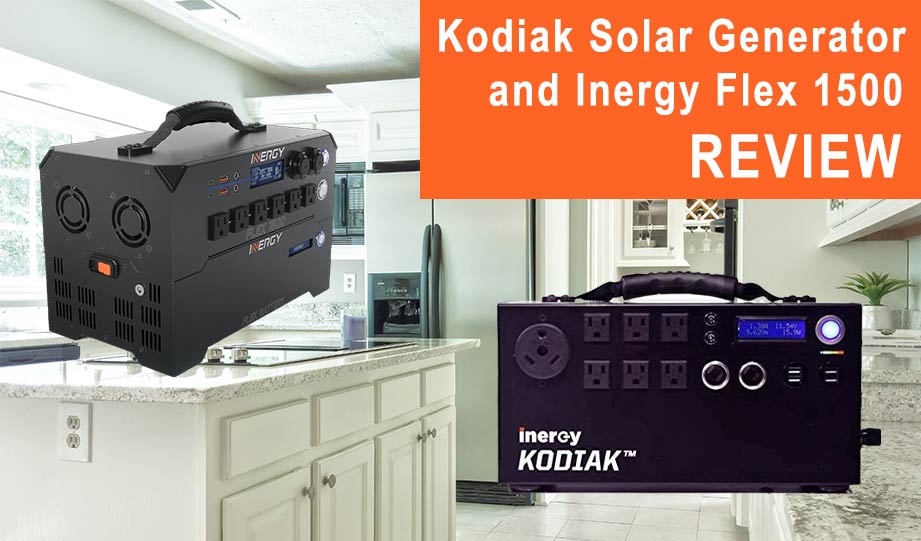
I recently had a power cut for 8 hours in the middle of the night.
I anxiously paced around my house, trying to contact the electricity provider and find out what was going on. During that time, my freezer was defrosting, my fridge food was warming up, and I was relying on my 30% smartphone battery for light.
Clearly, I needed a solution for when this happens again.
With this in mind, I decided to turn to the world of solar generators, namely the Inergy Kodiak Solar Generator.
Here’s what I discovered.
What Is The Kodiak Solar Generator?
The Inergy Kodiak Solar Generator was a great solar generator that could run a fridge for 33 hours or a chest freezer for 50 hours, so it was perfect for what I needed.
I absolutely loved the light 20 lb weight and convenient set of inputs and outputs on the Kodiak solar generator — it gave you various inputs and outputs including 6 AC plugs at up to 1,500 watts, a 30 amps RV plug (110V), 2 12V DC car sockets, 4 USB outlets and 2 LED light outputs.
Brilliant.
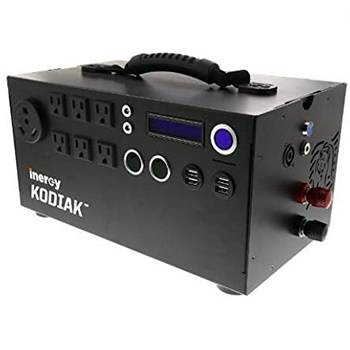
Sadly, the Kodiak Solar Generator has been discontinued.
Some of the previous Kodiak Solar Generator reviews have reviewed the Inergy Apex Solar Generator instead…
But that generator has been discontinued as well.
The Inergy Apex had a more refined look and better specs than the original Kodiak solar generator, and it appears that Inergy has looked to expand on this theme with their newest, NEWEST, power station.
You searched for a Kodiak Solar Generator review, but since it’s impossible for you to get your hands on a Kodiak anymore, we’re going to review Inergy’s new flagship power station for you instead — the Inergy Flex 1500 Power Station.
This Inergy Flex 1500 Power Station is the latest solar power system from Inergy, boasting a modular design with a great battery management system and slick LCD screen.
What Is The Inergy Flex 1500?
The Inergy Flex 1500 power station is a portable power station with a modular design.
Succeeding the Inergy Apex, the Flex 1500 comes with 3 distinct sections:
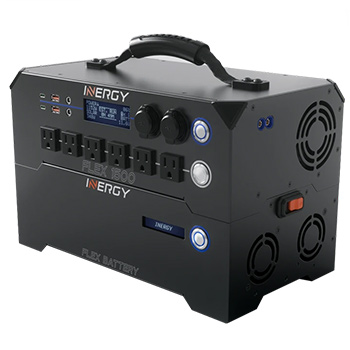
After basically copying the Point Zero Titan design, the batteries on this thing are stackable, meaning that you can stack up to 96 batteries for increased energy capacity… though I don’t think that 96 is very practical.
Maybe 2 or 3?
The outputs on the Inergy Flex 1500 include:
This gives you plenty of options for charging those devices when the lights go out.
Other key features of the Flex 1500 include:
Running at somewhere around 1,100 watt-hours with a continuous 3,000-watt pure sine surge, you’ll find that this thing is capable of powering most devices and household items, including your fridge.
However, the Flex 1500 seems to have lifted many of its ideas from the Point Zero Titan… it seems like everything apart from the pure sine wave inverter and charge controller.
For shame!
From the Jackery to the Titan and the Goal Zero Yeti, you’ll see many similar design features in the Kodiak Solar Generator, Inergy Apex and now the Inergy Flex 1500 as the company seems to look for its own USP.
What Can The Inergy Flex 1500 Power?
The Inergy Flex 1500 can power most household items and devices in the event of a blackout. This includes fridges, freezers, lights, smartphones, and more.
What Can The Inergy Flex 1500 Power Station Be Used For?
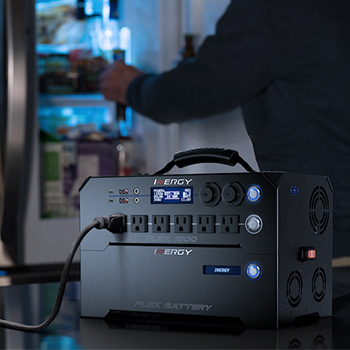
You can use the Inergy Flex 1500 power station as backup emergency power for blackouts and power cuts.
One of the best products for backup power, the Flex 1500 can charge via a wall charger, car charger, or solar panel kit, so you no longer need to rely on old-fashioned gas generator products.
What Is Inergy?
Inergy is an Indiegogo-funded company creating generator products and specialized lithium batteries for consumers who live an outdoor lifestyle or who want to be prepared for power cuts.
They were famous for the Kodiak Solar Generator and Inergy Apex power station, though their latest product is the Inergy Flex 1500 power station. There are many links and similarities between the Apex, Kodiak, and Flex 1500.
Inergy Flex 1500 Benefits
Eco-friendly Solar Panel Charging
Like many power station products in this price range, the Inergy Flex 1500 can be charged via solar panels.
This solar charging and the 600W solar charging speed allow the battery to charge quite quickly with solar panels, in 6 hours or less.
Still, the Point Zero Titan has a solar charging speed of 1,000W in comparison, so it’s not the best.
Nonetheless, you can use this power station without relying on fossil fuel power, so that’s nice.
Modular Design
Unlike the Inergy Apex and Kodiak, the Flex 1500 is a modular system comprising of 3 parts — the power console, the lithium-ion battery, and the MPPT supercharger.
The batteries are stackable, so you can charge up to 96 batteries for the ultimate capacity (although 96 is a stretch). You don’t get that with lead-acid.
However, I should point out that this stackable battery design was stolen from the Point Zero Titan, which also does it better in my opinion.
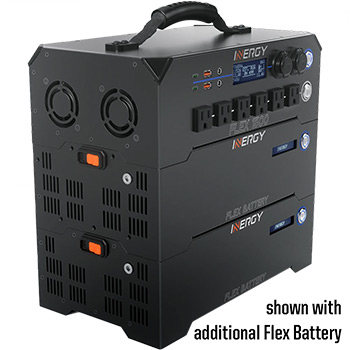
Indoor And Outdoor Friendly
Unlike some power generator products, the Flex 1500 solar system is suitable for both indoor and outdoor use, assuming you don’t leave it in a monsoon.
Don’t try that.
This is convenient for many different types of customers — you can use this thing for camping, RV trips, tiny houses, or just regular backup power.
Inergy Flex 1500 Shortfalls
Not That Many Watt Continuous Hours
Lots of other products in this price range have watt-hours in the 1,500 to 3,000 watt-hours range, yet the Flex 1500 has just 1,100 watt-hours, which is rather disappointing.
1,100 watt-hours will still be plenty for many users, but I just expected more.
Solar Charging Speed Isn’t Great
The portable solar power station can charge via solar panels and up to 600W.
However, products like the Point Zero Titan can solar charge at 1000W, nearly twice as fast as the Flex 1500.
AC Outputs Are Too Close Together
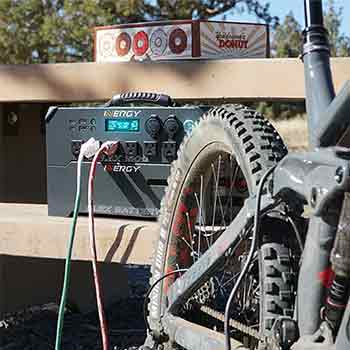
If you have a device with a large wall plug, then you might find that you can’t plug anything in either side of it because these AC outputs are so close together.
This is only a problem if you use devices with big chunky adaptors, but other power stations like the Jackery Explorer 1000 are just better designed to avoid this problem.
No RV Plug
For some bizarre reason, Inergy decided to get rid of the RV connector on the Flex 1500 despite including one on the Inergy Apex and Kodiak.
While there are still ways to use this product if you’re an RV user, it’s definitely nowhere near as convenient anymore, so you might be tempted to try a different product.
Battery Life Cycle Is Vague
Inergy is being weirdly cagey about their battery life cycles, sticking to the vague answer that it could vary from 400 charge cycles to 2,000 cycles depending on how you use it.
That’s not very helpful.
Annoyingly, this product hasn’t been released enough for me or any other reviewer to give a decent guess based on their experience.
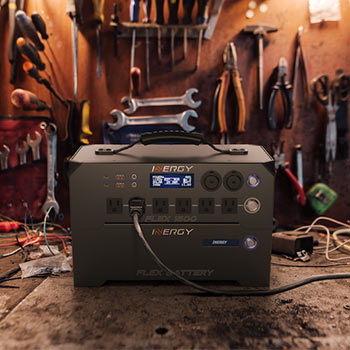
You can replace the battery due to the stackable battery balancing modular design, but it would be nice to know how long I can expect it to last.
Poor Customer Service History
Inergy is not known for its amazing customer service record, with many customers reporting problems with orders, shipping, and pre-sales orders.
I personally know a guy who spent 90 minutes on the phone talking to Inergy due to a question about his shipping. He got nowhere closer to solving his shipping problem and just wasted a good chunk of his day.
I don’t want that to be me.
Seems To Copy Other Products' Designs
From the Kodiak to the Apex and now the Flex 1500, I would like to question Inergy’s morals when it comes to certain activities.
If you compare photos and videos of the Flex 1500 and the Titan, for example, you see lots of design similarities and details, including the stackable battery design.
I’m not saying that they’ve copied all their products, but some royalty fees might be in order.
Pros and Cons Summary of the Inergy Flex 1500
Pros
Cons
Related Articles:
Things To Consider When Buying A Portable Solar Generator
What’s The Weather Like?
If you live in a region that’s very cloudy and overcast then you’re going to have a hard time getting any decent juice out of your solar panels.
For those who don’t live in sunny areas, you might want to look at alternative power sources.
What Are You Using It For?
If you’re buying a portable solar generator for camping or outdoor pursuits, then you want to get a product that is weatherproof, waterproof, and able to withstand damage from being thrown around haphazardly.
You will also want to make sure it has additional features like an LED torch and carry handle too, helping you out when you’re battling the forces of nature and whatnot.
On the other hand, if you’re using it indoors as backup power, you don’t need to worry too much about how much it weighs or whether it can get rained on.
How Much Power Do You Really Need?
A lot of people get excited when they read about the latest charge controller or pure sine wave inverter updates, but you need to consider what you actually need.
If you’re just expecting to charge a laptop and a couple of phones throughout a power cut, you don’t need a huge battery with a fancy inverter and all the inputs and outputs in the world — a small product like the Jackery Explorer 500 would be fine.
Do You Want To Expand Your Power?
Some power stations, like the Titan and Flex 1500, have the option for you to “stack” batteries, making it easy to expand your power capacity should your needs change in the future.
Most products do not have this option.
FAQ
No, a solar generator cannot power a whole house. However, it can power some of your larger devices and household appliances, including your TV and fridge/freezer.
Most people find that a 1,500-watt solar generator does more than enough to meet their needs. However, avid campers and off-the-grid adventurers may want to look at 3,000 watts or more.
Solar generators are worth the money if you use them often enough and you live in an area with at least 5-6 hours of strong sunlight daily. If you live in cloudier conditions or are more concerned with backup power, a regular power station may be better.
A solar generator of 1,500 watts or more should be enough to run your refrigerator for several hours until the grid power comes back on. This can help to prevent spoiled food and defrosting during a power cut. Try to find a generator with a pure sine wave inverter too.
The Inergy Flex 1500: Should You Buy It?
The Inergy Flex 1500 certainly has its upsides, but I wouldn’t add it to my shopping cart if I were you. It’s heavy, has vague life cycles for its batteries, and its AC plugs are too close together so you can’t plug things in next to each other for many devices.
Urgh.
Instead, I’d recommend the Jackery Explorer 500. It’s much smaller and cheaper, but it’s more than enough to keep you going in a power cut situation in a few hours.
If you need more power and more (well-spaced apart) AC plugs, then you could try the Jackery Explorer 1000 too.
These power stations are much more user-friendly, and they have enough power to keep your devices topped up when the power goes down. These products are small and lightweight (13 lbs and 22 lbs) compared to the bulky 30 lb Flex 1500.
If you’re looking for emergency backup power and you don’t need to power the Las Vegas strip during those few hours, then I would recommend the Jackery Explorer. It’s more than enough power and doesn’t cost a fortune or weigh a ton.

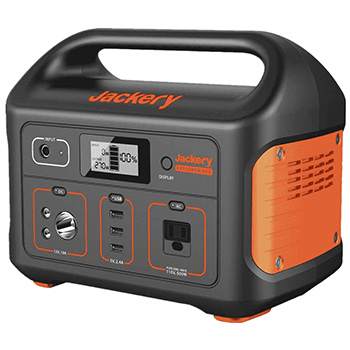









My Inergy Kodiak X2 is only about a month old and is malfunctioning. Inergy customer service isn’t good. My unit doesn’t stay powered on after three weeks of sitting plugged in and unused. After initially charging my unit on house mains the battery state of charge displayed 100%. I plugged in a small 12ov light and it worked as expected. The display showed power going out and the estimated run time. I checked the 120v AC ports and 12v DC port with a multimeter. The utility light on the front of the unit and all the switches were working as expected. Everything looked okay. I unplugged my 120v AC and 12v DC test loads and let it sit. I didn’t use it for a few weeks. Then I powered it on, the display comes on, and the cooling fan spools up just in time for the unit to shut itself off. I emailed them twice before they responded asking me how I charged it. I told them from house AC. A week later now, and no reply. When I’ve emailed each time a different person has responded. So I tried calling them, at least four times. The only option was to leave a callback number. They did call and I missed it. But I was trying to get somewhere with them by email so I didn’t call again. I tried their chat bot they promote on their website. It said they were online and two groups showed available. I shared my information only to receive a message that nobody was available and to leave a callback number. After all this they sent me a 40 day survey. Unbelievably, all I could do was select a rating by radio button. The text boxes in the survey wouldn’t work on the phone. It didn’t matter because I couldn’t even submit the review anyway. I finally clicked a link in the survey and was able to get it to work. I’m amazed how many things could possibly go wrong for me with Inergy. It’s crazy. For me, nothing customer facing has really worked with them. They have good designs, who’s ever they are, maybe they have some technical team members. Their modular Flex system is a great solution for the right customer. I can accept that because they cost reduced these manufacturing in China, they will have some failures. What I have a problem with is their horrible customer service. I’m really disappointed as I really wanted to support an American company who I believed designed a quality product.
I have been waiting for my additional battery for my Apex unit since October 2020. All I’ve gotten was a “professional” run around as to when it would be delivered. First delay reason was the Monsoon Season. Second and third reason for the delay (Feb 2021) was because of Corvid and UPS. It’s now July 2021 and I have asked three time about delivery and timing and all three responses were a copy and paste…”because of Corvid and UPS”…. My wife thinks I’ve been spammed (I paid for the unit in full an few months ago) . We’ll see how this works out but I’m not getting my hopes up. The Apex unit works well and honestly I’m happy with it’s performance but the customer service is the worst I’ve ever experienced in my life (70 years).